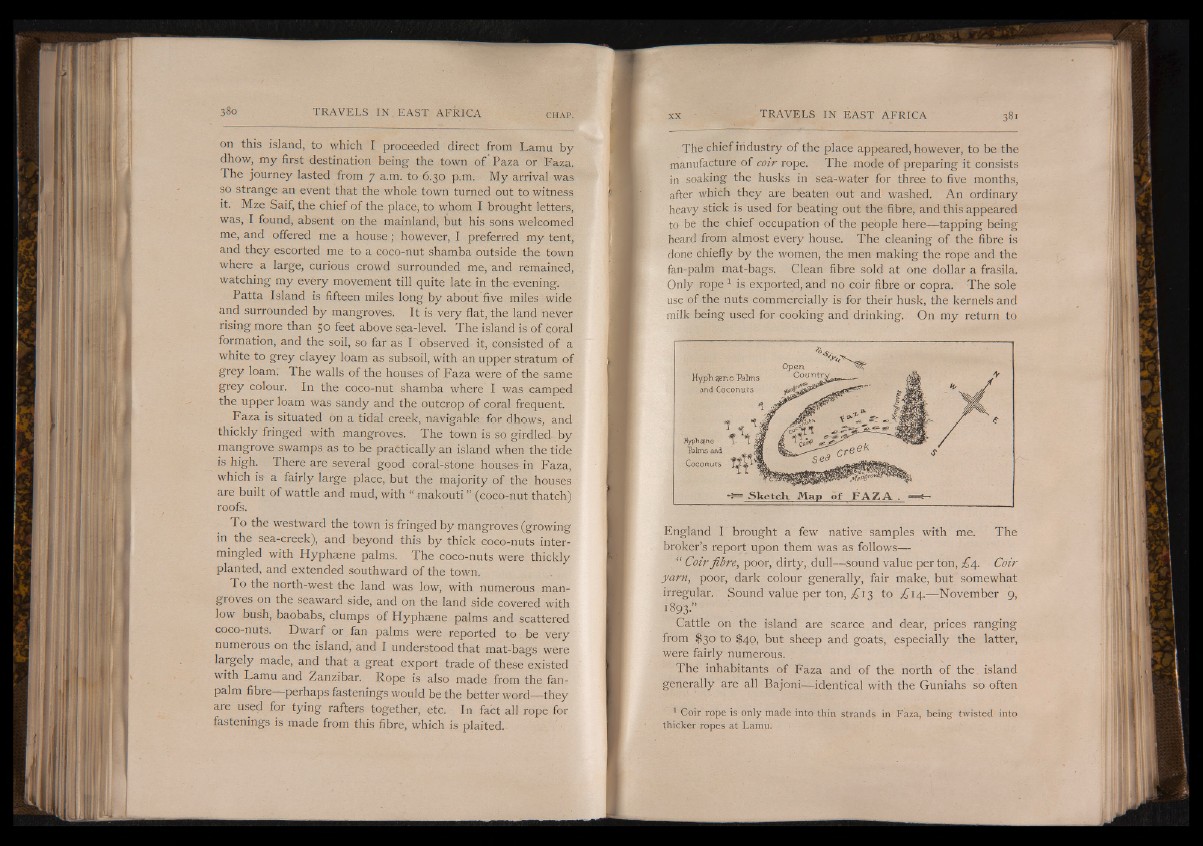
on this island, to which I proceeded direct from Lamu by
dhow, my first destination being the town of Paza or Faza.
The journey lasted from 7 a.m. to 6.30 p.m. My arrival was
so strange an event that the whole town turned out to witness
it. Mze Saif, the chief of the place, to whom I brought letters,
was, I found, absent on the mainland, but his sons welcomed
me, and offered me a house; however, I preferred my tent,
and they escorted me to a coco-nut shamba outside the town
where a large, curious crowd surrounded me, and remained,
watching my every movement till quite late in the evening.
Patta Island is fifteen miles long by about five miles wide
and surrounded by mangroves. It is very flat, the land never
rising more than 50 feet above sea-level. The island is of qoral
formation, and the soil, so far as I observed it, consisted of a
white to grey clayey loam as subsoil, with an upper stratum of
grey loam: The walls of the houses of Faza were of the same
grey colour. In the coco-nut shamba where I was camped
the upper loam was sandy and the outcrop of coral frequent.
Faza is situated on a tidal creek, navigable for dhows, and
thickly fringed with mangroves. The town is so girdled by
mangrove swamps as to be practically an island when the tide
is high. There are several good coral-stone houses-in Faza,
which is a fairly large place, but the majority of the houses
are built of wattle and mud, with “ rnakouti ” (coco-nut thatch)
roofs.
To the westward the town is fringed by mangroves (growing
in the sea-creek), and beyond this by thick coco-nuts intermingled
with Hyphaene palms. The coco-nuts were thickly
planted, and extended southward of the town.
To the north-west the land was low, with numerous mangroves
on the seaward side, and on the land side covered with
low bush, baobabs, clumps of Hyphaene palms and scattered
coco-nuts. Dwarf or fan palms were reported to be very
numerous on the island, and I understood that mat-bags were
largely made, and that a great export trade of these existed
with Lamu and Zanzibar. Rope is also made from the fan-
Palm fibre— perhaps fastenings would be the better word— they
are used for tying rafters together, etc. In fact all rope for
fastenings is made from this fibre, which is plaited.
The chief industry of the place appeared, however, to be the
manufacture of coir rope. The mode of preparing it consists
in soaking the husks in sea-water for three to five months,
after which they are beaten out and washed. An ordinary
heavy stick is used for beating out the fibre, and this appeared
to be the chief occupation of the people here— tapping being
heard from almost every house. The cleaning of the fibre is
done chiefly by the women, the men making the rope and the
fan-palm mat-bags. Clean fibre sold at one dollar a frasila.
Only rope1 is exported, and no coir fibre or copra. The sole
use of the nuts commercially is for their husk, the kernels and
milk being used for cooking and drinking. On my return to
England I brought a few native samples with me. The
broker’s report upon them was as follows—
“ Coir fibre, poor, dirty, dull— sound value per ton, £4. Coir
yarn, poor, dark colour generally, fair make, but somewhat
irregular. Sound value per ton, 3 to £14.— November 9,
1893.”
Cattle on the island are scarce and dear, prices ranging
from $30 to $40, but sheep and goats, especially the latter,
were fairly numerous.
The inhabitants of Faza and of the north of the island
generally are all Bajoni— identical with the Guniahs so often
1 Coir rope is only made into thin strands in Faza, being twisted into
thicker ropes at Lamu.